Whether you're at the grocery store, butcher shop, or market, shopping for meat can be a tricky game—and sometimes even dangerous. Safety is undoubtedly a top concern, reiterated time and time again by food experts like Mitzi D Baum, CEO at Stop Foodborne Illness. Baum notes that "foodborne illness can be life-threatening" and that an estimated 3,000 people in the U.S. die each year from something they ate. The CDC expands on this statistic, reporting that 48 million people get sick from these illnesses each year, and infections like salmonella and E. coli are top concerns when it comes to meat.
Quality is another key factor when buying beef, pork, or poultry. According to Ian Dodson, vice president of culinary operations at J. Alexander's Restaurants, being observant can help you sniff out the safest and tastiest options for you and your family.
"When I walk around the supermarket looking for a protein to take center stage for dinner, I'm often intrigued by the number of people who grab the first pack of ground beef or chicken breasts without looking at what they are buying," Dodson says. He also recounts times at the steakhouse when patrons have asked him questions like "Why doesn't it taste this good when I make it at home?" noting that both common scenarios are potential indicators of buying low-quality meat.
To help you avoid this, Dodson and other experts share a few tricks of the trade and characteristics to watch out for the next time you're at the meat counter. It's critical to be aware of these subtle warning signs that you're buying an inferior or potentially threatening product.
Reduced Price Deals

With grocery prices as high as they are, you may light up at the sight of discounted chicken or meat with a "reduced" price sticker attached. Luis Mata, butcher and co-founder of Meat N' Bone, a nationwide purveyor of premium meats for the home cook, warns to approach these low-cost products skeptically.
"Typically, the reasons for lower-than-average prices are not in the consumer's favor," Mata says. "It's rare that the price drop is simply due to a grocer or butcher needing to clear excess stock. More commonly, a low price can indicate that the meat has been sitting for an extended period, is nearing spoilage, or is inherently of inferior quality."
Meat prices are often fairly stable—barring any economic or weather-related issues similar to what Americans have experienced over the last few years, which have driven costs up. So, any price that is substantially lower or a significant deviation from the norm should be viewed as a red flag, Mata says. On the other hand, he says that paying a little bit more is often synonymous with better quality and freshness.
Missing Labels
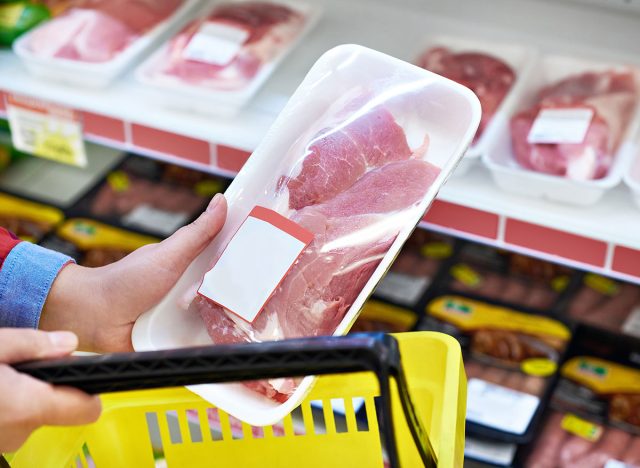
"Transparency in sourcing and grading is a telltale sign of high-quality meat," Mata says. "If the packaging lacks clear information on the grade of the meat and its origin, it's worth questioning the quality. Reputable suppliers and quality meat programs take pride in their products and are typically eager to display this information prominently."
Specifically, if you're in the market for a great cut of beef, look for labels with grades like USDA Prime, Choice, or Select. These classifications indicate the beef's quality based on factors such as marbling, tenderness, flavor, and maturity. Produced from young cattle with abundant marbling, Prime is the USDA's highest grade—this is typically what you would be served in a steakhouse or high-end hotel. For poultry and pork, on the other hand, scan for labels stating that the meat is organic, free-range, or has any other certification.
Mata explains that the absence of this kind of detailed information is cause for concern. This could mean that the product doesn't meet high safety standards, the origin is less reputable, or it lacks quality in terms of flavor and texture. "Always prioritize meat with clear, informative labeling that reassures you of its quality and traceability, and be cautious of products that lack this transparency," he says.
Discoloration
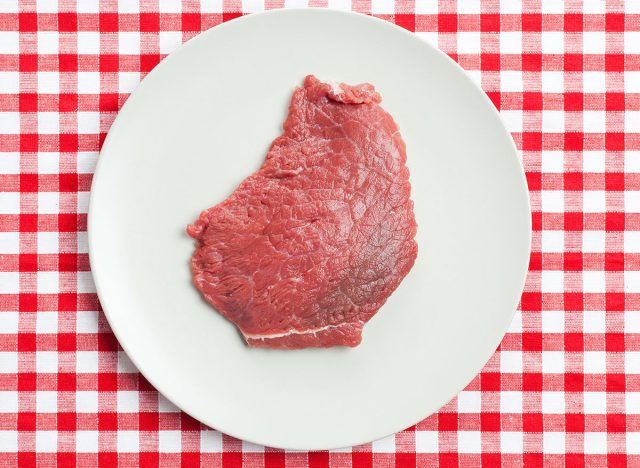
Dodson says you'll want to "use all of your senses to judge freshness" when shopping for meat. This inevitably begins with sight, and the most important physical feature you'll want to note is color.
"Meats can become sponges for bacteria growth, and as they age in display cabinets, they will often discolor," Dodson says. "Beef items will go from dark red to brown. When the color turns, it shows age but not in a good way."
Baum from Stop Foodborne Illness explains that this color change from red, or even pink, to brown is a direct result of oxidation. She says while this reaction typically doesn't affect the safety of the meat, it can mean that it wasn't packaged or sealed tightly enough so oxygen could seep in or that it has been in the case for a longer period.
Strange Textures or Smells

After a quick color check, you'll also want to tap into your sense of touch and smell to identify other spoilage indicators. "Don't be afraid to smell what you are buying," Dodson says. "Fresh beef will have a little odor, almost a little sweet, but there should be no sour or acid smell to the meat." As a general rule of thumb, if the meat you're inspecting smells pungent, off-putting, or objectively bad, it likely is. (Obviously, conducting a smell test in a store can be difficult if the product is tightly packaged.)
In terms of texture, watch out for slimy or tacky meat. Baum adds that the skin may become sticky for poultry like chicken and turkey, and wings may turn an off-color if the bird isn't fresh. Similarly, beef and pork cuts can also succumb to a gummy, shiny, or crusty exterior.
You can even test meat's firmness—an excellent age indicator—with some quick pokes through the cellophane. Fresh, quality meat should slowly bounce back afterward, while spoiled meat will stay indented.
Poor Storage Conditions
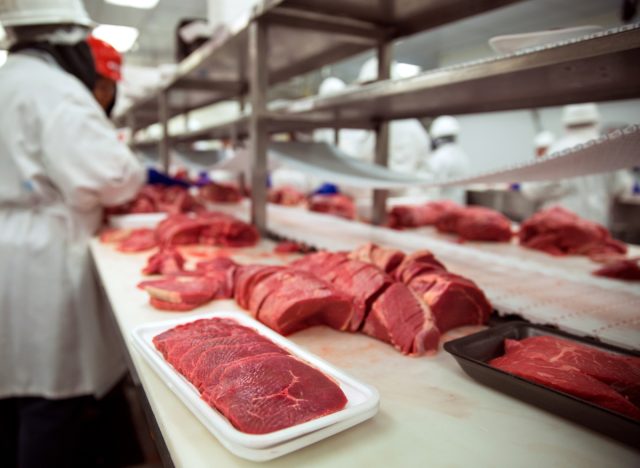
They say not to judge a book by its cover. But, in the meat department, you should. At many supermarkets, most meats are packaged using styrofoam trays and plastic wrap. According to Mata, this is an insufficient packing technique that can lead to more oxygen exposure and, subsequently, the quicker degradation of proteins and loss of overall quality.
Instead, look for meats that have been vacuum-sealed. This packaging method helps to slow down oxidation and bacterial growth. Plus, it contributes to the wet aging process, where the meat becomes more tender and flavorful as it sits in its own juices under controlled conditions.
Proper storage is another critical piece of the puzzle. Mata explains that meat should typically be stored at around 29.5 degrees Fahrenheit to maintain optimal conditions. At many grocery stores or markets where open-air cases are used, temperatures can rise to 40 degrees Fahrenheit, teetering in the unsafe zone and possibly compromising the meat's integrity and safety.
"To ensure you are buying meat that has been stored under the best conditions, consider purchasing from retailers that use closed and well-regulated refrigeration systems, and always check that the meat is stored at consistent, appropriately cold temperatures," Mata says. "If purchasing from a case, opt for meat that is deeper inside the cooler, where temperatures are more likely to remain stable."
Added Ingredients or Previously Frozen Meat
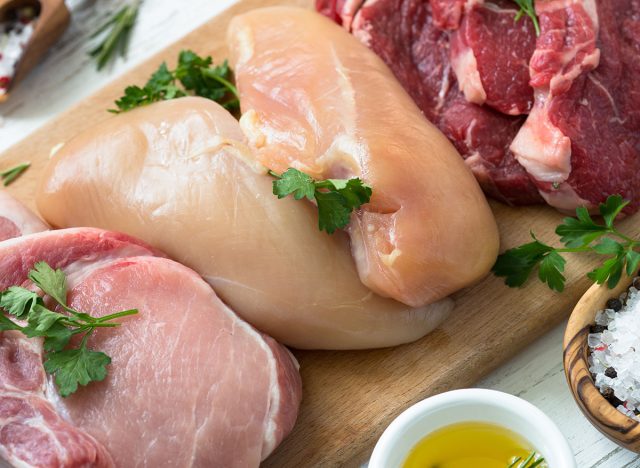
In addition to beef grades and organic stickers, there are a few other details to look out for when reviewing meat's packaging label. Dodson says that meat, especially chicken and pork, can be injected with saline, water, or other ingredients for juiciness and flavor and to increase the product's shelf life. This happens more than you might think. In 2011, the USDA reported that around 15% of beef, 30% of poultry, and 90% of pork are injected with some kind of liquid solution before sale.
This is negative for the consumer because you receive less meat per pound, and these "enhanced" products contain significantly more sodium than those left untreated. Reading the fine print—specifically, keeping an eye out for terms like "injected with …" can help you know exactly what you're buying and avoid spending money on unwanted add-ins.
While you're reading the fine print, look for any indications that the meat was previously frozen. Freezing and thawing can change the appearance of meat and affect its moisture levels and overall taste.
Excess Fat or Sloppy Cuts
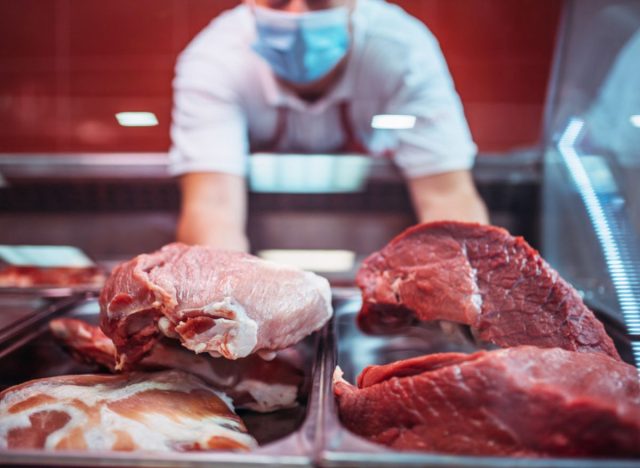
It's important to remember that your meat is only as good as the butcher you get it from. To ensure the best quality, you'll want to pay close attention to how your meat is trimmed and cut.
"Some grocers and butchers may not trim excess fat from steaks and other cuts, which can artificially increase the weight of the meat," Mata says. "This practice allows them to charge a lower price per pound while effectively selling a product with a higher proportion of inedible material. Customers might initially perceive this as getting more for their money, but in reality, they are purchasing a cut that has been poorly butchered or trimmed."
Mata also notes that "poor butchery might manifest in uneven cuts." He says that properly trained and experienced butchers should sell cuts that are well-shaped and proportioned to not only cook evenly but also present well on your plate. "Investing in meat from reputable sources where butchers adhere to high standards in both trimming and cutting can ensure better quality, better tasting, and more visually appealing dishes," he says.
No comments:
Post a Comment